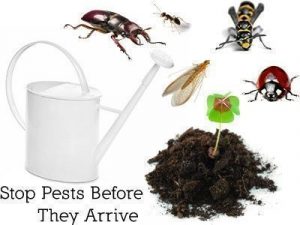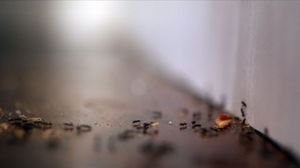 Colorado State University, the USDA, and Colorado counties created the following guidelines for dealing with Pest Problems After Storms. Thanks wonderful Steve Armstead for sharing info:
Colorado State University, the USDA, and Colorado counties created the following guidelines for dealing with Pest Problems After Storms. Thanks wonderful Steve Armstead for sharing info:
September 17, 2013. There are several pests of concern around structures after the recent floods: flies, cockroaches, nuisance invaders, mosquitoes, bedbugs, carpenter ants, wasps, molds & mildews, and rats & mice. Additional information on how to control pest problems in ways that are safe for human and environmental health can be found at http://coloradoipmcenter.agsci.colostate.edu/.
Flies When electrical power is lost for extended periods, perishable foods begin to spoil and house flies and blow flies are attracted to these decaying items and may reproduce rapidly if these foods are accessible. (See the fact sheet Flies in the Home discusses these insects and their management: http://www.ext.colostate.edu/pubs/insect/05502.html). Over ripe fruit and fermenting matter that supports growth of yeasts can allow small fruit flies (vinegar flies) to breed (http://bspm.agsci.colostate.edu/files/2013/03/Fruit-Flies.pdf ). Water-soaked hay and straw, particularly if mixed with animal manure and urine, provides optimal breeding areas for stable flies, the “biting house fly” (http://www.ext.colostate.edu/pubs/insect/05582.html ).
Place spoiled foods in trash bags and discard them in garbage cans until trash is picked up, or carry them to a landfill or  other municipal disposal site. Make sure that garbage can lids fit tightly. Food that is carelessly discarded or placed in unsecured garbage cans or in bags simply stacked on the ground will attract displaced hungry wildlife, such as raccoons, skunks, stray dogs and small rodents.
other municipal disposal site. Make sure that garbage can lids fit tightly. Food that is carelessly discarded or placed in unsecured garbage cans or in bags simply stacked on the ground will attract displaced hungry wildlife, such as raccoons, skunks, stray dogs and small rodents.
Water-soaked lawns, compost piles, discarded carpeting, padded furniture, insulation and clothing may become moldy and serve as breeding grounds for fungus gnats and other flies. Water-soaked compost piles, grass clippings or bales of hay and straw may attract stable flies. The adult flies may show up in about 7-10 days (depending on the time of year) and become a nuisance. People leave their windows and doors open to improve air circulation, particularly when electrical service is disrupted or when homes are flooded. Unscreened windows and doors (or ones with damaged or poorly fitting screens) provide flies with easy access to homes. Use sticky “fly strips” to trap the flies. Do not use “pest strips” (impregnated with chemicals such as DDVP) in occupied closed rooms. Aerosol insecticides may control flies temporarily, but more flies will appear once the chemical has dissipated. Pesticides should not be applied around people who have respiratory problems.
 Damaged septic lines, damaged sewer pipes (both under houses and along roads) and other waste system components will attract a variety of small flies, including “humpbacked flies”, minute scavenger flies and moth flies. Moth flies showing up outdoors or inside may be a sign that you need to check your septic system and crawl space for possible damage to septic lines or waste pipes. . (A sheet on moth flies is accessible at: http://bspm.agsci.colostate.edu/files/2013/03/Moth-Flies.pdf.)
Damaged septic lines, damaged sewer pipes (both under houses and along roads) and other waste system components will attract a variety of small flies, including “humpbacked flies”, minute scavenger flies and moth flies. Moth flies showing up outdoors or inside may be a sign that you need to check your septic system and crawl space for possible damage to septic lines or waste pipes. . (A sheet on moth flies is accessible at: http://bspm.agsci.colostate.edu/files/2013/03/Moth-Flies.pdf.)
Carcasses of animals killed in the storm or in subsequent flooding will attract blowflies in particular. Carcass removal is critical to minimizing fly problems; however, the severity of post- storm conditions may affect how and when disposal can occur. Listen for instructions from county or state health officials regarding what methods are appropriate for your area. For small animals (domestic or wild), incineration or disposal in an appropriate landfill are preferable. In some emergencies, local officials may approve immediate burial 3 feet deep, but check with your local government before burying dead animals. Do not place animal carcasses in dumpsters unless you are directed to do so; this will only aggravate fly problems if the dumpsters cannot be emptied regularly. See http://www.ext.colostate.edu/pubs/insect/05502.html
Cockroaches The oriental cockroach, sometimes called a “water bug”, lives in sewer drains, damp crawl spaces, basements and cellars. As water levels rise in those areas, this cockroach will often climb up and out of pipes leading underground and infest kitchen areas. The three keys to effective cockroach management are prevention and sanitation, detection and chemical control. See our fact sheet at http://www.ext.colostate.edu/pubs/insect/05553.html.
Eliminate unnecessary water sources, food, and hiding places. Dispose of trash regularly as to not create food and shelter sources. Repair any leaks or plumbing malfunctions because cockroaches are attracted to water sources and damp environments. Store food in pest-safe containers. Caulk and install weather stripping where cockroaches can potentially enter the building. Use cockroach traps to locate areas with high population density. Traps will not eliminate an established colony, but are a useful tool in determining what your next steps should be. Place traps under sinks, against walls, in dark corners, and in cabinets. If the traps remain empty after a couple of days, then move traps to another likely location.
Nuisance Invaders Several kinds of insects and other arthropods (spiders, centipedes, millipedes) occasionally enter  buildings. Flooding may displace some of these, particularly ones that live in the ground, which may accelerate migrations into homes.
buildings. Flooding may displace some of these, particularly ones that live in the ground, which may accelerate migrations into homes.
Among the arthropods that may increase indoor migrations over the next month as a result of flooding are funnel weaver spiders (http://bspm.agsci.colostate.edu/files/2013/03/Funnel-Weaver-Spiders1.pdf),, centipedes, millipedes and sowbugs (http://www.ext.colostate.edu/pubs/insect/05552.html), and field crickets.
Mosquitoes Although we are near the end of the “mosquito season”, due to the incidence of West Nile Virus, it is important to decrease habitat where mosquitoes can breed. For tips on mosquito management, see http://www.ext.colostate.edu/westnile/mosquito_mgt.html.
Turn over pails, empty planters or anything that can hold stagnant water. Clear gutters. Fill natural depressions in landscaping, tree holes and rotten stumps with sand to absorb water retained after rainfall. Clean up litter and debris in the yard that can collect water and enable mosquito breeding. Cover openings for standing water sources, such as septic tanks, rain barrels, and catch basins with fine mesh screening. Mow tall grass to reduce shady areas where mosquitoes prefer to rest.
Bedbugs The situations surrounding a disaster may increase the possibility that you may bring bedbugs into your home. Bedbugs are easily transported on clothing and furniture. Bed bug infestations are not directly related to sanitation levels. However, excess amounts of clutter in and around beds and sleeping areas will offer bed bugs numerous places to hide near potential blood meals. Bed bugs can enter the cleanest of homes by way of luggage, clothing, or borrowed furnishings. They can be found on used furniture, which is why it is a good idea to thoroughly inspect (and dismantle if possible) any piece of used furniture prior to bringing it into your home. See http://www.ext.colostate.edu/pubs/insect/05574.html
Control methods include:
Inspect and monitor areas with upholstered furniture and carpeting. Remove clutter. Vacuum to remove bed bugs and debris that may serve as shelter. Dispose of infested clothing or treat it in a hot dryer (140°F) for at least 20 minutes. Eliminate shelter by sealing cracks and crevices with a silicone-based sealant. Seal around utility ducts. Using a combination of techniques, with products that pose the lowest risk to health and environment, is most effective in managing bed bugs. Spraying alone is not recommended. Aerosol “bombs” (containing pyrethrins or permethrin) and sprays of non-persisting insecticides (such as pyrethrins or tetramethrin) will not be effective for bed bug control.
Carpenter ants Moisture damaged wood can provide sites where carpenter ants will nest. Although carpenter ants are not common problems in many urban areas, the presence of water damage to structures may increase incidence of these insects in future years. The sooner one begins the temporary or permanent repairs to replace water-damaged wood, the less likely will be future problems with carpenter ants.See http://www.ext.colostate.edu/pubs/insect/05554.html
Yellowjackets and other wasps At the time of the 2013 flooding the annual nests produced by yellowjackets, baldfaced hornets, and paper wasps were already starting to break apart and queens had begun to disperse to find protected sites for overwintering. If anything, the flooding had an adverse impact on these insects, particularly the ground nesting yellowjackets, and may result in a reduced number of these stinging insects in fall 2013. During storm cleanup, protective clothing such as gloves boots, hat and long pants are highly recommended. See http://www.ext.colostate.edu/pubs/insect/05525.html
Potential moisture problems Uncorrected moisture problems in the walls, crawlspace or attic can lead to other serious pest problems, such as wood-decaying fungi or later with wood-boring beetles in framing wood. Mold/mildew growing on wood or insulation can also attract nuisance pests, which can slowly build up in numbers and become a chronic problem. You need a moisture meter to determine if you have excess moisture in your crawlspace, attic or framing wall. Keep a few important facts in mind:
Mold/ mildew on surfaces can pose some health issues and needs to be addressed as quickly as possible. Mold/mildew growing on joists or beams does not mean that wood is decaying (or will decay). Wood-decaying fungi do not grow below the fiber-saturation point (28-30% moisture) of the wood. Problems with wood boring beetles are less likely to occur when the wood’s moisture content is below 14%. This level may be difficult to reach immediately. Do not seal up walls until the wood moisture content is as least down to 19% (preferably closer to 15%).
It may take some time to decrease the wood moisture in the crawlspace.
Make sure foundation vents open properly and they are clear of debris. Remove standing water from the crawlspace as soon as possible. Increase ventilation to the crawlspace. This can be a simple matter of opening the crawlspace door or using a fan to pull air OUT of the crawlspace, assuming that weather conditions (and availability ofelectricity) allow you to do so. You may have to use some large-mesh metal screening over the crawlspace door to keep out animals, such as raccoons and skunks. Remove and replace wet insulation in crawlspaces and walls.
Rodents The rain and wind will damage rodents’ natural nesting spots and force them to higher ground, including into your home. Damaged household goods, along with tree trunks and limbs, and other storm debris that are piled on the property or fall into culverts, drainage ditches or streams quickly become nesting sites for displaced rats and mice. Loosened soil around holes left by fallen trees also make ideal burrowing sites. Damage to your home’s exterior provides animals with easier access to relatively sheltered areas, such as your crawlspace, basement, attic or even wall voids. People involved in cleanup and repairs may carelessly discard food and beverage items, which quickly attract rodents searching for food.
Watch for signs of rodent activity. Norway rats usually nest in underground burrows. However, in flooded areas, they will move to “high ground” and may be found nesting indoors. Look for signs of gnawing; rats can chew through many materials, including siding, walls, cardboard boxes, etc., to gain entry to an area. Look for fecal droppings, which are found in nesting and/or feeding areas. Clear debris around houses and buildings as soon as possible; debris provides protective cover for rodents. If you cannot remove debris from the site immediately, place it as far as possible from the building. Keep lawn and field vegetation mowed, particularly near buildings, to eliminate protective cover for rodents. Remove or contain potential food sources such as household trash, spoiled or discarded food, bird or grass seed in a storeroom, etc., that might attract mice and rats. Do not leave bowls of pet food outdoors overnight. They attract rats and other animals, such as skunks, fox, and raccoons, to your home. Depending on their age and size, rats can fit through openings as small as a quarter and mice may fit through openings the size of dime. Seal gaps around water pipes, utility line entry points, vents, crawlspace accesses and doors. Rodents can chew easily through foam and dried caulk to gain entry. Use a material such as copper mesh, Extruder or 1/4- inch mesh galvanize hardware cloth to close large openings. Use snap traps to capture rats and mice indoors. Do not place traps in areas where children and pets may be able to reach them. Check the traps daily and dispose of carcasses quickly and appropriately to avoid problems with flies. When handling traps that have caught rodents, wear gloves (preferably ones that can be rinsed in bleach).
Rodent baits must be used with great care. The disruptions that take place during clean- up activities after storms may make it difficult to get rodents to visit baited locations. When baiting outdoors the bait must be secured, e.g., inside a tamper-resistant bait stations, so that it cannot be removed by the rodent and possibly dropped in an open area where children, pets or wildlife can get to it. Do not use bait packets or loose bait. Community-wide problems are best handled by the municipality or a pest control professional after cleanup is underway. As with situations where you use snap-traps, check areas for rodent carcasses and remove them quickly before stray animals find and possibly eat them (and in the process become sick from the anticoagulant chemical in the bait). NEVER place baits or traps in areas where they are accessible to children, pets or wildlife. Always follow the instructions on rodenticide labels carefully.
Colorado State University, U.S. Department of Agriculture and Colorado counties cooperating.
Extension programs are available to all without discrimination. No endorsement of products mentioned is intended nor is criticism implied of products not mentioned.
This information was adapted from North Carolina State University. http://www.ces.ncsu.edu/depts/ent/notes/Urban/storm/index.htm
